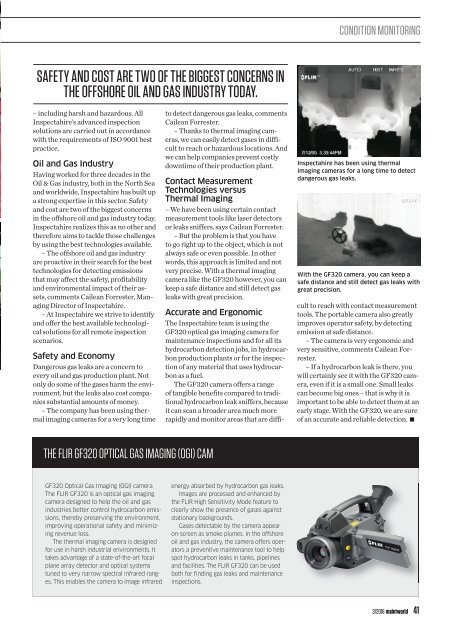Maintworld Issue3 2016
You also want an ePaper? Increase the reach of your titles
YUMPU automatically turns print PDFs into web optimized ePapers that Google loves.
CONDITION MONITORING<br />
SAFETY AND COST ARE TWO OF THE BIGGEST CONCERNS IN<br />
THE OFFSHORE OIL AND GAS INDUSTRY TODAY.<br />
– including harsh and hazardous. All<br />
Inspectahire’s advanced inspection<br />
solutions are carried out in accordance<br />
with the requirements of ISO 9001 best<br />
practice.<br />
Oil and Gas Industry<br />
Having worked for three decades in the<br />
Oil & Gas industry, both in the North Sea<br />
and worldwide, Inspectahire has built up<br />
a strong expertise in this sector. Safety<br />
and cost are two of the biggest concerns<br />
in the offshore oil and gas industry today.<br />
Inspectahire realizes this as no other and<br />
therefore aims to tackle those challenges<br />
by using the best technologies available.<br />
– The offshore oil and gas industry<br />
are proactive in their search for the best<br />
technologies for detecting emissions<br />
that may affect the safety, profitability<br />
and environmental impact of their assets,<br />
comments Cailean Forrester, Managing<br />
Director of Inspectahire.<br />
– At Inspectahire we strive to identify<br />
and offer the best available technological<br />
solutions for all remote inspection<br />
scenarios.<br />
Safety and Economy<br />
Dangerous gas leaks are a concern to<br />
every oil and gas production plant. Not<br />
only do some of the gases harm the environment,<br />
but the leaks also cost companies<br />
substantial amounts of money.<br />
– The company has been using thermal<br />
imaging cameras for a very long time<br />
to detect dangerous gas leaks, comments<br />
Cailean Forrester.<br />
– Thanks to thermal imaging cameras,<br />
we can easily detect gases in difficult<br />
to reach or hazardous locations. And<br />
we can help companies prevent costly<br />
downtime of their production plant.<br />
Contact Measurement<br />
Technologies versus<br />
Thermal Imaging<br />
– We have been using certain contact<br />
measurement tools like laser detectors<br />
or leaks sniffers, says Cailean Forrester.<br />
– But the problem is that you have<br />
to go right up to the object, which is not<br />
always safe or even possible. In other<br />
words, this approach is limited and not<br />
very precise. With a thermal imaging<br />
camera like the GF320 however, you can<br />
keep a safe distance and still detect gas<br />
leaks with great precision.<br />
Accurate and Ergonomic<br />
The Inspectahire team is using the<br />
GF320 optical gas imaging camera for<br />
maintenance inspections and for all its<br />
hydrocarbon detection jobs, in hydrocarbon<br />
production plants or for the inspection<br />
of any material that uses hydrocarbon<br />
as a fuel.<br />
The GF320 camera offers a range<br />
of tangible benefits compared to traditional<br />
hydrocarbon leak sniffers, because<br />
it can scan a broader area much more<br />
rapidly and monitor areas that are diffi-<br />
Inspectahire has been using thermal<br />
imaging cameras for a long time to detect<br />
dangerous gas leaks.<br />
With the GF320 camera, you can keep a<br />
safe distance and still detect gas leaks with<br />
great precision.<br />
cult to reach with contact measurement<br />
tools. The portable camera also greatly<br />
improves operator safety, by detecting<br />
emission at safe distance.<br />
– The camera is very ergonomic and<br />
very sensitive, comments Cailean Forrester.<br />
– If a hydrocarbon leak is there, you<br />
will certainly see it with the GF320 camera,<br />
even if it is a small one. Small leaks<br />
can become big ones – that is why it is<br />
important to be able to detect them at an<br />
early stage. With the GF320, we are sure<br />
of an accurate and reliable detection.<br />
THE FLIR GF320 OPTICAL GAS IMAGING (OGI) CAM<br />
GF320 Optical Gas Imaging (OGI) camera<br />
The FLIR GF320 is an optical gas imaging<br />
camera designed to help the oil and gas<br />
industries better control hydrocarbon emissions,<br />
thereby preserving the environment,<br />
improving operational safety and minimizing<br />
revenue loss.<br />
The thermal imaging camera is designed<br />
for use in harsh industrial environments. It<br />
takes advantage of a state-of-the-art focal<br />
plane array detector and optical systems<br />
tuned to very narrow spectral infrared ranges.<br />
This enables the camera to image infrared<br />
energy absorbed by hydrocarbon gas leaks.<br />
Images are processed and enhanced by<br />
the FLIR High Sensitivity Mode feature to<br />
clearly show the presence of gases against<br />
stationary backgrounds.<br />
Gases detectable by the camera appear<br />
on-screen as smoke plumes. In the offshore<br />
oil and gas industry, the camera offers operators<br />
a preventive maintenance tool to help<br />
spot hydrocarbon leaks in tanks, pipelines<br />
and facilities. The FLIR GF320 can be used<br />
both for finding gas leaks and maintenance<br />
inspections.<br />
3/<strong>2016</strong> maintworld 41

















